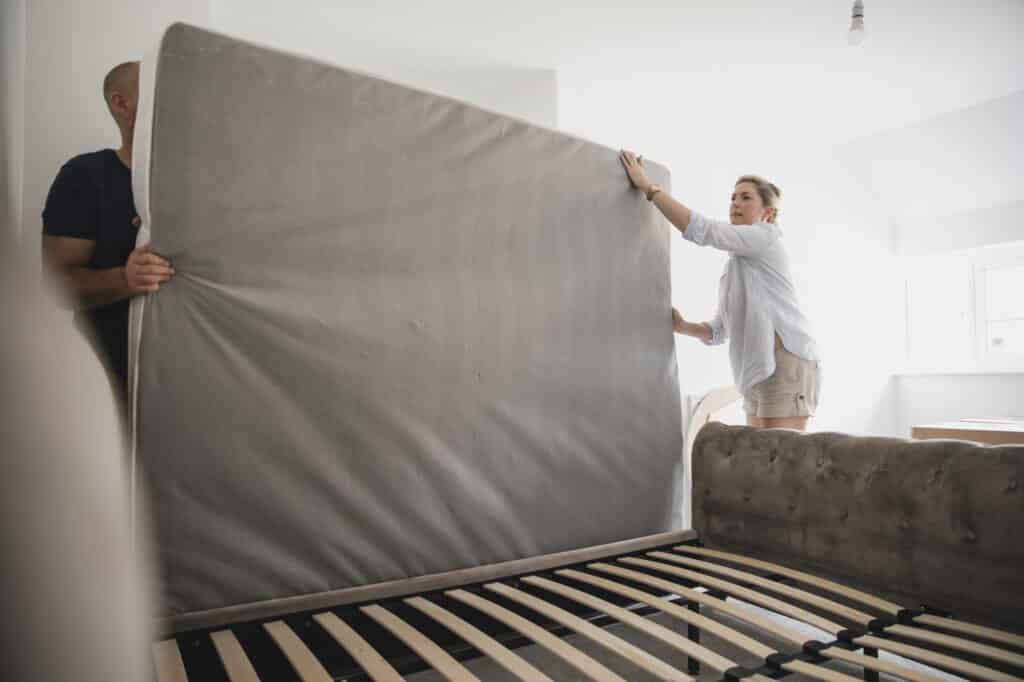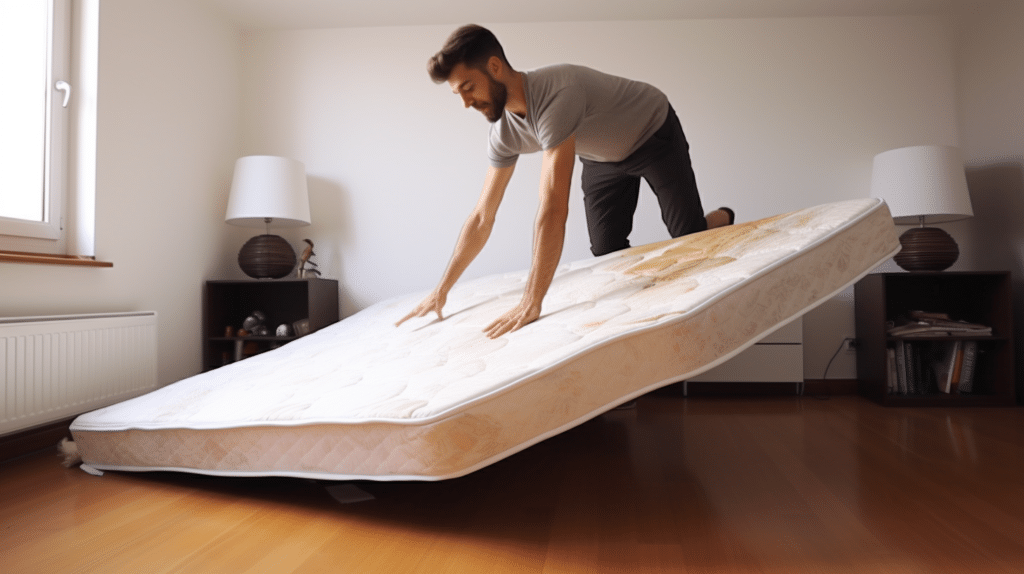Looking for a way to alleviate your allergies and improve your sleep quality? Consider investing in a hypoallergenic mattress. Allergens found in traditional mattresses can disrupt your sleep and exacerbate allergy symptoms. In this article, we will explore the benefits of hypoallergenic mattresses, different types available, factors to consider when choosing one, and common misconceptions. We’ll also provide customer reviews and ratings of popular brands, as well as tips for purchasing a hypoallergenic mattress on a budget. Say goodbye to restless nights and hello to allergy relief!
Understanding Allergies and Their Impact on Sleep Quality
Understanding allergies can greatly affect your quality of sleep. Allergies are triggered by various substances such as pollen, dust mites, pet dander, and mold. When you are exposed to these allergens, your body releases chemicals that cause symptoms like sneezing, itching, and congestion. These discomforts can make it difficult for you to fall asleep and stay asleep throughout the night.
In addition to the immediate symptoms, there is also a connection between allergies and sleep disorders. Allergies can worsen conditions like asthma or sleep apnea, leading to disrupted breathing patterns during sleep. This can result in snoring, gasping for air, or even pauses in breathing.
To improve your sleep quality and reduce the impact of allergies on your restfulness, it’s important to understand your allergy triggers and take steps to minimize exposure. One effective measure is investing in a hypoallergenic mattress that is designed to repel allergens like dust mites and mold. By creating a barrier between you and these irritants, you can experience a more peaceful and restorative night’s sleep.
Types of Allergens Found in Traditional Mattresses
To address your concerns about allergens, it’s important to know the types of irritants commonly found in traditional mattresses. These allergens can have a significant impact on your sleep quality and overall health. Here are three sub-lists that highlight the different types of allergens present in traditional mattresses:
- Dust mites: These microscopic creatures thrive in warm and humid environments, feeding on dead skin cells. Their feces contain proteins that trigger allergic reactions.
- Mold: Moisture buildup within mattresses can lead to mold growth. Breathing in mold spores may cause respiratory problems, such as coughing and wheezing.
- Pet dander: If you allow your furry friend to sleep with you, their dander can accumulate in your mattress. This can cause allergies or worsen existing ones.
Exposure to these allergens can result in a range of health effects, including sneezing, itching, congestion, and even difficulty breathing. It’s crucial to choose a hypoallergenic mattress that provides protection against these common irritants for a healthier sleep environment.
The Benefits of Hypoallergenic Mattresses
If you suffer from allergies, a hypoallergenic mattress can provide significant benefits. These mattresses are designed to minimize the presence of dust mites and bedbugs, which can trigger allergic reactions. Additionally, they resist the growth of mold and mildew, ensuring a healthier sleeping environment. Lastly, hypoallergenic mattresses eliminate allergenic materials that could cause discomfort or respiratory issues, allowing you to sleep soundly and comfortably.
Minimizing Dust Mites and Bedbugs
To minimize dust mites and bedbugs, you can consider using a hypoallergenic mattress. These mattresses are designed to prevent the accumulation of allergens and pests in your bed, ensuring a healthier sleep environment. Here are four ways a hypoallergenic mattress can help with dust mite prevention and bedbug extermination:
- Dust mite barriers: Hypoallergenic mattresses often have tightly woven fabrics that act as a barrier, preventing dust mites from penetrating the surface.
- Anti-microbial properties: Some hypoallergenic mattresses are treated with anti-microbial agents that inhibit the growth of allergens and pests like bedbugs.
- Allergen-free materials: These mattresses are made with materials that do not attract or harbor allergens, making it difficult for dust mites and bedbugs to survive.
- Easy to clean: Hypoallergenic mattresses are usually easy to clean, allowing you to remove any potential hiding spots for pests.
Investing in a hypoallergenic mattress can greatly reduce the risk of allergies caused by dust mites and the annoyance of dealing with bedbugs.
Resisting Mold and Mildew Growth
One way to resist mold and mildew growth is by regularly cleaning and airing out your mattress. By doing this, you can prevent allergen accumulation and maintain a hypoallergenic mattress. To start, remove all bedding and vacuum the mattress surface using an upholstery attachment. Pay special attention to the seams and edges where dust, dirt, and debris tend to accumulate. Once vacuumed, wipe down the mattress with a mixture of vinegar and water or use an enzyme-based cleaner specifically designed for mold and mildew removal. After cleaning, let your mattress air out in a well-ventilated area for a few hours before remaking the bed with fresh linens. Remember to wash your bedding frequently in hot water to further prevent allergen buildup. By following these simple steps, you can keep your hypoallergenic mattress free from mold, mildew, and other potential allergens.
Eliminating Allergenic Materials
Eliminating allergenic materials is essential for maintaining a hypoallergenic mattress. When choosing an alternative mattress material, look for options that are resistant to dust mites, mold, and other common allergens. Natural materials like latex and organic cotton are great choices as they have anti-microbial properties and repel dust mites naturally. These materials also provide excellent support and comfort for a good night’s sleep.
In addition to selecting the right materials, it’s important to consider mattresses that have hypoallergenic certifications. Look for certifications such as CertiPUR-US or Oeko-Tex Standard 100, which ensure that the mattress has been tested for harmful substances and meets specific standards for quality and safety.
By eliminating allergenic materials in your mattress and choosing certified hypoallergenic options, you can create a healthier sleep environment free from allergens that can trigger allergies or asthma symptoms.
Exploring Different Types of Hypoallergenic Mattresses
If you’re looking for a hypoallergenic mattress, there are several different types to consider. Latex mattresses are known for being naturally resistant to mold, dust mites, and other allergens. Memory foam mattresses can also be a good option as they have a dense structure that prevents the accumulation of allergens. Additionally, organic cotton and wool mattresses are great choices for those with allergies as they are made with natural materials that are less likely to cause irritation or trigger allergies.
Latex Mattresses
When it comes to latex mattresses, there are many hypoallergenic options available. Latex mattress benefits include their ability to resist dust mites, mold, and other common allergens. This is due to the natural properties of latex, which make it inhospitable for these irritants. Not only are latex mattresses great for allergy sufferers, but they also offer exceptional durability. The elasticity of latex allows it to retain its shape and support over time, making it a long-lasting investment for your sleep comfort. Additionally, latex mattresses provide excellent motion isolation, so you won’t be disturbed by your partner’s movements during the night. Whether you prefer a firm or plush feel, there is a latex mattress out there that can cater to your specific preferences and needs while providing a hypoallergenic sleep environment.
Memory Foam Mattresses
Now that you know about latex mattresses, let’s explore another option: memory foam mattresses. If you’re looking for a mattress that provides both support and comfort while being hypoallergenic, memory foam might be the perfect choice for you. Memory foam molds to your body shape, relieving pressure points and ensuring a restful sleep. One of its key benefits is its ability to absorb movement, making it an excellent choice for couples who don’t want to disturb each other during the night. When comparing memory foam to latex, it’s important to consider personal preference. While latex offers bounce and responsiveness, memory foam provides a contouring feel that some people find more comfortable. Ultimately, choosing between these two materials depends on your specific needs and preferences for a good night’s sleep free from allergens.
Organic Cotton and Wool Mattresses
Organic cotton and wool mattresses offer a natural and sustainable option for those seeking a comfortable and eco-friendly sleep surface. These mattresses are made with materials that have been grown without the use of harmful chemicals, making them hypoallergenic and great for people with allergies or sensitivities.
Here are three reasons why organic cotton and wool mattresses are worth considering:
- Breathability: The natural fibers in these mattresses allow for better airflow, keeping you cool in the summer and warm in the winter.
- Moisture-wicking: Organic cotton and wool have excellent moisture-wicking properties, helping to regulate your body temperature and keep you dry throughout the night.
- Environmentally friendly: By choosing an organic cotton or wool mattress, you’re supporting sustainable farming practices that reduce water usage, pesticide contamination, and overall environmental impact.
Investing in an organic cotton or wool mattress not only benefits your health but also contributes to a healthier planet. So why not make a conscious choice for both yourself and the environment?
Factors to Consider When Choosing a Hypoallergenic Mattress
One important factor to consider when choosing a hypoallergenic mattress is the material it is made of. Hypoallergenic mattresses are designed to minimize allergy symptoms by reducing allergen accumulation. They are typically made from materials such as latex, memory foam, or microfiber that repel dust mites and other allergens. These materials have a tighter cell structure, making it harder for allergens to penetrate and accumulate in the mattress. Additionally, hypoallergenic mattresses often come with removable and washable covers that can be easily cleaned to further reduce allergen exposure. By choosing a hypoallergenic mattress, you can experience the benefits of reduced allergies and better sleep quality. It is important to carefully consider the material used in your mattress to ensure it meets your specific needs for allergy relief and overall comfort.
Additional Measures to Reduce Allergens in the Bedroom
To reduce allergens in your bedroom, there are several additional measures you can take. Firstly, make sure to regularly clean and vacuum your room to remove dust and other allergens. Secondly, use hypoallergenic bedding and pillow covers to create a barrier between yourself and potential triggers. Lastly, maintaining proper humidity levels can help prevent the growth of mold and reduce dust mite populations.
Regular Cleaning and Vacuuming
Make sure you regularly clean and vacuum your mattress to reduce allergens. Regular maintenance is essential in keeping allergens at bay. Dust mites, one of the main triggers for allergies, thrive in mattresses if not properly cleaned. Here are three tips to help you enjoy a clean and allergy-free sleep environment:
- Use a vacuum cleaner with a HEPA filter: This powerful filter can effectively capture even the tiniest dust mite particles that may be lurking in your mattress.
- Spot treat stains promptly: Accidents happen, but it’s important to address any spills or stains on your mattress as soon as possible. Use mild cleaning solutions and blot the area gently.
- Rotate and flip your mattress regularly: By doing this every few months, you can prevent dust mites from accumulating in specific areas of your mattress.
By following these simple steps, you can create a cleaner sleeping environment and minimize allergy symptoms caused by dust mites.
Using Hypoallergenic Bedding and Pillow Covers
To create a more allergy-friendly sleep environment, consider using hypoallergenic bedding and pillow covers. These options are perfect for children who suffer from allergies, as they provide several benefits. Hypoallergenic bedding is made from materials that are less likely to cause an allergic reaction, such as cotton or bamboo. This means that your child can sleep comfortably without worrying about sneezing or itching throughout the night. Additionally, hypoallergenic pillow covers are especially beneficial for asthma sufferers. They create a barrier between the pillow and the person’s face, preventing allergens like dust mites from being inhaled during sleep. By using these covers, you can help reduce asthma symptoms and improve overall breathing while sleeping. So make sure to invest in hypoallergenic bedding and pillow covers to promote a healthier sleep environment for you and your loved ones.
Maintaining Proper Humidity Levels
Don’t forget to monitor and adjust the humidity levels in your bedroom for a more comfortable sleep environment. Maintaining proper humidity control can have significant health benefits, especially for those with allergies. High humidity levels can promote the growth of mold, dust mites, and other allergens that can trigger symptoms like sneezing, coughing, and congestion. On the other hand, low humidity levels can lead to dry skin, irritated eyes, and respiratory issues. To achieve optimal comfort and reduce allergen exposure, aim for a relative humidity level between 30% to 50%. You can use a hygrometer to measure the humidity in your bedroom and consider investing in a humidifier or dehumidifier to regulate it accordingly. By keeping the moisture levels balanced, you’ll create an environment that is less prone to allergens and better suited for a restful night’s sleep.
Common Misconceptions About Hypoallergenic Mattresses
Did you know that there are common misconceptions about hypoallergenic mattresses? Addressing these misconceptions is important to ensure that you make an informed decision when choosing a mattress for allergy relief. One of the most common myths is that hypoallergenic mattresses are completely allergen-free. While these mattresses are designed to minimize allergens, they cannot eliminate them entirely. Another misconception is that all hypoallergenic mattresses are made of natural materials. In reality, there are synthetic materials used in some hypoallergenic mattresses that can still provide effective allergy relief. Additionally, some people believe that hypoallergenic mattresses are only necessary for individuals with severe allergies. However, even those with mild allergies can benefit from using a hypoallergenic mattress as it can help reduce exposure to allergens and improve overall sleep quality. By debunking these myths, you can make a more informed choice when selecting a hypoallergenic mattress.
Customer Reviews and Ratings of Popular Hypoallergenic Mattress Brands
Now that you know the common misconceptions about hypoallergenic mattresses, let’s dive into customer reviews and ratings of popular brands. Hearing from other customers can provide valuable insights before making a purchase. Many online retailers allow customers to leave testimonials, giving you a firsthand look at how well these mattresses have performed for others with allergies. Alongside customer feedback, it’s also important to consider expert recommendations. Professionals in the industry have tested and analyzed various hypoallergenic mattress brands, offering their expertise on which ones are truly effective in reducing allergens. By combining both customer testimonials and expert recommendations, you can make an informed decision when choosing a hypoallergenic mattress that suits your needs and provides a good night’s sleep free from allergies.
Tips for Purchasing a Hypoallergenic Mattress on a Budget
If you’re on a budget, there are some tips to help you find an affordable hypoallergenic mattress. When it comes to budget-friendly options, consider looking for mattresses made with alternative materials. Many hypoallergenic mattresses are constructed using natural latex or memory foam, which can be more expensive. However, there are also affordable options available that use synthetic latex or polyfoam instead. These materials still provide the hypoallergenic benefits without breaking the bank. Another tip is to shop during sales or take advantage of discounts and promotions offered by mattress retailers. You can also consider purchasing online as many online mattress companies offer competitive prices and often have deals and discounts available. By following these tips, you can find a hypoallergenic mattress that fits your budget without compromising on quality or comfort.
Conclusion
So there you have it, by choosing a hypoallergenic mattress, you can significantly improve your sleep quality and alleviate allergy symptoms. With various types of hypoallergenic mattresses available, such as latex or memory foam options, you can find the perfect one to suit your needs. Don’t be fooled by common misconceptions about hypoallergenic mattresses – they are a worthwhile investment for anyone dealing with allergies. Take the time to read customer reviews and consider your budget when making a purchase. Say goodbye to restless nights and hello to a healthier sleep environment!


